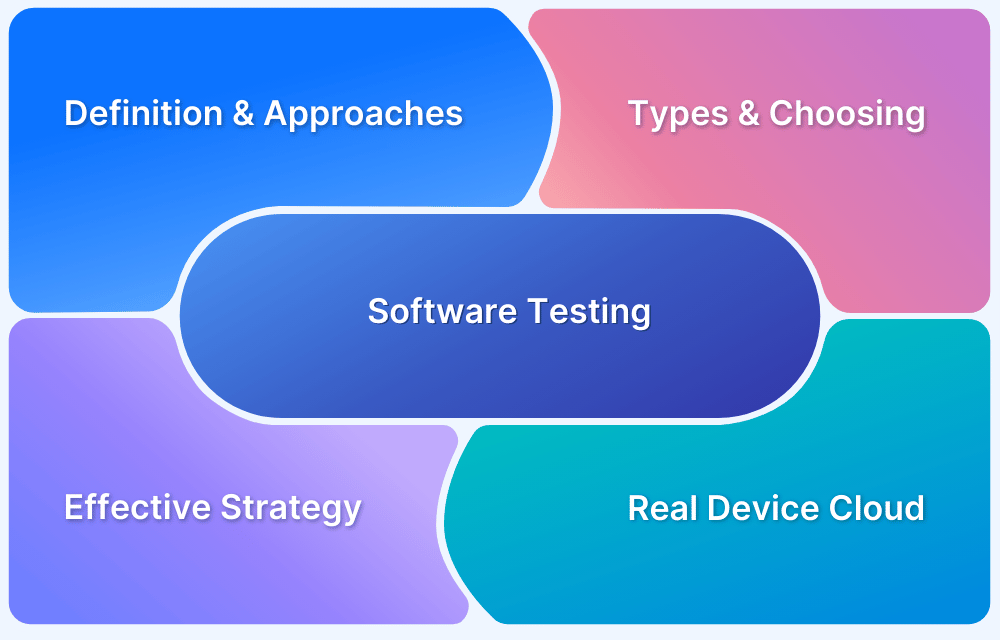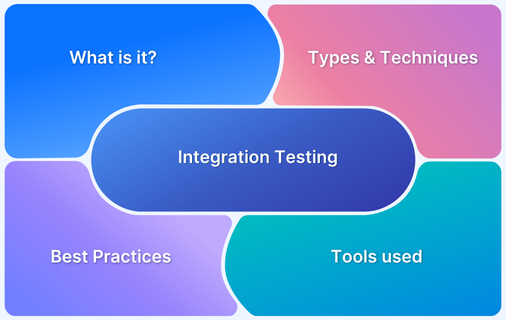What is Combinatorial Testing?
By Abishek Balakumar, Community Contributor - January 7, 2025
Combinatorial Testing (CT) is a software testing technique that evaluates interactions between multiple input variables. By systematically combining inputs, it efficiently detects defects while reducing the number of test cases, making it ideal for complex systems.
How It Works
- CT focuses on detecting defects caused by interactions between one or two parameters.
- It tests combinations of these parameters for more efficient defect detection.
- CT uses covering arrays (CAs) to verify t-way interactions.
- This ensures that all relevant combinations of parameters are tested.
Benefits of Combinatorial Testing
- Automates test case generation, saving manual effort and time.
- Identifies critical defects early, reducing debugging and maintenance costs.
- Ensures comprehensive testing with fewer test cases.
- Handles complex systems with many configurations and dependencies.
- Reduces the test suite size by 20 to 700 times while maintaining the same fault detection as exhaustive testing.
Applications
CT is widely used in software engineering, particularly for testing autonomous systems, verifying AI/ML models, and ensuring the reliability of complex applications across various industries.
Tools
- Pairwiser is a popular combinatorial testing tool that provides a visualizer to display the coverage of each test case, making it easier to manage and interpret test results.
- AnkrPt Pairwise is a lightweight and fast combinatorial testing tool that specializes in pairwise testing.
This article will discuss the benefits and strategies of combinatorial testing for enhancing software reliability and efficiency.
- What is Combinatorial Testing?
- When to Perform Combinatorial Testing
- Importance of Combinatorial Testing in Software Testing
- What is a Combinatorial Test Case?
- How to Perform Combinatorial Testing
- Benefits of Combinatorial Testing Tools
- Top 5 Combinatorial Testing Tools
- Manual Combinatorial Testing
- Automated Combinatorial Testing
- Challenges of Combinatorial Testing
- Best Practices of Combinatorial Testing
What is Combinatorial Testing?
Combinatorial testing involves analyzing the behavior of a system by testing various combinations of input parameters. Instead of testing all possible permutations (which may be computationally infeasible), this approach uses intelligent sampling methods like pairwise or n-wise testing to focus on critical combinations that are most likely to reveal defects.
For example:
- If a system has three input variables—browser type, operating system, and device type—combinatorial testing systematically tests their combinations, such as Chrome on Windows on Desktop or Safari on macOS on iPhone.
Key terms:
- Pairwise Testing: Focuses on testing all possible pairs of input parameters.
- n-Wise Testing: Expands coverage to include n-way combinations for deeper interaction testing.
Also Read: Pair Testing: A Beginner’s Guide
When to Perform Combinatorial Testing
Here’s when you should perform combinatorial testing:
- High Configurability: Systems with numerous configurations, such as web applications with multiple browser and device combinations.
- Limited Testing Resources: Projects requiring maximum coverage with minimal test cases.
- Complex Interdependencies: Systems where multiple variables influence functionality simultaneously.
- Regression Testing: To verify new changes do not disrupt previous functionality.
Importance of Combinatorial Testing in Software Testing
Below are the reasons why it is important to perform combinatorial testing:
- Enhanced Test Coverage: Ensures systematic exploration of variable interactions.
- Efficiency: Reduces the number of test cases without compromising on defect detection.
- Cost-Effectiveness: Detects defects early, lowering the cost of fixing bugs.
- Scalability: Ideal for systems with increasing complexity and interdependencies.
- Improved Quality Assurance: Delivers robust and reliable software by addressing interaction-specific bugs.
- Automation-Friendly: Seamlessly integrates with automation tools like.
Also Read: Test Case Templates with Example
What is a Combinatorial Test Case?
A combinatorial test case is a specific set of input parameters selected based on predefined rules (like pairwise or orthogonal array strategies). Each test case represents one combination of variables, designed to validate a particular interaction within the system.
Example: For a flight booking app:
- Variables: Payment method, destination, and number of passengers.
- Test Case: Credit Card + London + 2 Passengers.
These combinations ensure coverage of unique interaction scenarios between the inputs.
How to Perform Combinatorial Testing
Combinatorial testing is a powerful technique to efficiently test software applications by focusing on combinations of input parameters.
To perform Combinatorial Testing:
- Identify key input parameters and their possible values that impact application behavior.
- Choose a combinatorial testing strategy, such as pairwise, all-pairs, or orthogonal array testing.
- Generate and execute test cases manually or using automated tools, ensuring efficiency and accuracy.
- Compare expected and actual results, log defects and evaluate test coverage for parameter interactions.
- Refine test cases and re-execute to improve coverage and confirm defect fixes.
- Continuously optimize the testing process for better efficiency and effectiveness.
Additional Considerations
- Risk-Based Testing: Prioritize test cases based on the perceived risk of potential defects.
- Combinatorial Testing Tools: Utilize tools like PICT, ACT, and pairwise to automate test case generation and execution.
- Integration with Test Management: Integrate combinatorial testing into your overall test management process for better tracking and reporting.
By following these steps and considering the additional factors, you can effectively implement combinatorial testing to improve your software testing efforts and enhance the quality of your applications.
Benefits of Combinatorial Testing Tools
Combinatorial testing tools offer an efficient and automated way to generate and execute test cases for systems with multiple input variables.
Their benefits include:
- Time Efficiency: Automates test case generation, significantly reducing manual effort and time.
- Cost Reduction: Detects critical defects early in development, cutting down debugging and maintenance costs.
- Optimized Coverage: Ensures comprehensive testing of input combinations while minimizing the number of test cases.
- Enhanced Quality: Identifies interaction-specific defects that might otherwise go unnoticed.
- Scalability: Handles complex systems with numerous configurations and dependencies.
- User-Friendly Interfaces: Many tools provide intuitive GUIs and integration with CI/CD pipelines.
- Flexibility: Supports various levels of testing, from pairwise to higher-order combinations.
Top 5 Combinatorial Testing Tools
Below are the top five combinatorial testing tools:
- AnkrPt Pairwise: AnkrPt Pairwise is a lightweight and fast combinatorial testing tool that specializes in pairwise testing. It is particularly effective for scenarios with limited resources, providing a balance between simplicity and robustness. Users can define constraints and customize test cases, making it adaptable to diverse testing requirements.
- Testcover.com: Testcover.com is a web-based combinatorial test case generator. It supports pairwise, 3-wise, and n-wise testing, offering customizable settings to suit different testing needs. The platform is ideal for teams that prefer a browser-accessible tool with quick setup and results visualization.
- Pairwiser: Pairwiser is a versatile tool designed for both manual and automated test case generation. It offers a user-friendly interface for creating pairwise combinations and integrates with popular automation frameworks. Its flexibility makes it suitable for small to medium-sized projects.
- CAGen (Covering Array Generator): CAGen is a powerful open-source tool developed for generating covering arrays, including pairwise and higher-order combinations. It is highly customizable and supports advanced testing scenarios with intricate input dependencies. The tool is ideal for academic research and projects requiring extensive configuration.
- Pairwise PICT Online: Developed by Microsoft, Pairwise PICT Online offers a browser-based implementation of its renowned pairwise testing algorithm. It is efficient in generating test cases for high-dimensional input spaces and supports constraint-based modeling to handle interdependent variables effectively.
Manual Combinatorial Testing
While automated tools dominate the landscape, manual combinatorial testing can be used in small-scale projects or for systems with minimal configuration variables. Testers manually design combinations using orthogonal arrays or pairwise strategies.
Though cost-effective in simple scenarios, manual methods can become infeasible as the number of variables increases.
Automated Combinatorial Testing
Automated combinatorial testing leverages advanced algorithms and tools to generate, execute, and analyze test cases. Tools like BrowserStack Automate streamline the process by integrating combinatorial testing into CI/CD workflows, ensuring faster feedback and continuous improvement.
BrowserStack Automate is a market leader in cloud-based testing solutions, enabling organizations to execute combinatorial testing across a wide range of real devices and browsers.
It offers:
- Seamless Integration: Works with CI/CD tools for automated workflows.
- Parallel Execution: Accelerates test execution with concurrent sessions.
- Comprehensive Coverage: Supports diverse input combinations, ensuring robust testing.
By leveraging BrowserStack Automate, teams can ensure high-quality software releases while reducing testing overhead.
Challenges of Combinatorial Testing
Combinatorial testing, while powerful, is not without its challenges. Understanding and addressing these obstacles is key to successful implementation:
- High Dimensionality: As the number of input variables and their possible values increases, the complexity of test case generation grows exponentially, making even combinatorial methods resource-intensive.
- Constraint Management: Some input combinations may be invalid or irrelevant, requiring advanced tools to model and exclude such constraints effectively.
- Test Data Preparation: Generating appropriate test data for all combinations can be time-consuming and may require significant effort.
- Tool Dependency: Effective combinatorial testing often relies on specialized tools. A lack of expertise in using these tools can hinder adoption and effectiveness.
- Defect Traceability: Isolating and replicating defects uncovered by combinatorial test cases can be complex, particularly for higher-order interactions.
- Limited Coverage Beyond n-wise: While pairwise and n-wise testing are efficient, they may miss critical defects involving interactions between more variables than planned.
Best Practices of Combinatorial Testing
Below are some best practices to perform combinatorial testing:
- Prioritize Variables: Focus on variables that are most likely to interact and cause defects, such as those critical to system functionality or with high change frequencies.
- Define Clear Objectives: Clearly outline the testing goal, whether it’s defect detection, performance analysis, or regression verification.
- Use Automation Tools: Leverage tools like BrowserStack Automate for efficient test case generation and execution.
- Model Constraints Accurately: Define rules to exclude invalid or redundant combinations, streamlining test case generation and reducing execution time.
- Start with Pairwise Testing: Begin with pairwise testing for broad coverage and gradually move to higher-order combinations if required.
- Integrate into CI/CD: Incorporate combinatorial testing into continuous integration workflows for timely feedback and bug detection.
- Analyze Results Thoroughly: Use analytics to identify trends in defect occurrences and refine test cases for subsequent cycles.
- Review and Iterate: Regularly update test cases to reflect changes in system requirements or input parameters.
Conclusion
Combinatorial testing is a critical methodology for ensuring high-quality software in complex systems. By systematically analyzing variable interactions, it uncovers defects that traditional methods might overlook. While challenges such as constraint management and tool dependency exist, adopting best practices and leveraging automation tools like BrowserStack Automate can maximize its potential.
Incorporating combinatorial testing into your testing strategy ensures efficient resource utilization, robust defect detection, and enhanced software reliability. As technology evolves, this methodology remains a cornerstone of comprehensive software quality assurance.




